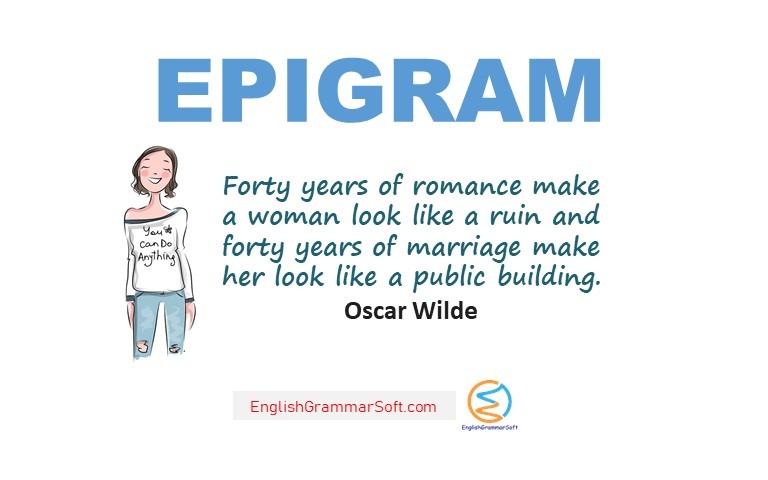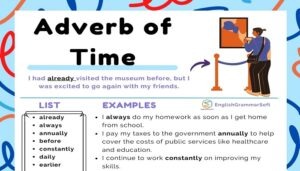What is Epigram in Figure of Speech? Definition, Examples, Sentences
Epigram
It was first known use in 15th Century.
Etymology of epigram
Middle English epigrame, from Latin epigrammat-, epigramma, from Greek, from epigraphein to write on, inscribe, from epi- + graphein to write
History of epigram
Ancient Greeks and Romans used the word epigramma (from Greek epigraphein, meaning “to write on”) to refer to a concise, witty, and often satirical verse. The Roman poet Martial (who published eleven books of these epigrammata, or epigrams, between the years 86 and 98 C.E.) was a master of the form: “You puff the poets of other days, / the living you deplore. / Spare me the accolade: your praise / Is not worth dying for.” English speakers adopted the “verse” sense of the word when we first used epigram for a concise poem dealing pointedly and often satirically with a single thought or event in the 15th century. In the late 18th century, we began using epigram for concise, witty sayings, even if they didn’t rhyme.
Definitions
- A short, witty statement in verse or prose which may be complimentary, satiric or aphoristic.
- A concise poem dealing pointedly and often satirically with a single thought or event and often ending with an ingenious turn of thought.
- An epigram is a short, pithy saying, usually in verse, often with a quick, satirical twist at the end. The subject is usually a single thought or event.
Explanation
Originally an inscription on a monument or statue, the epigram developed into a literary genre. Many of them are gathered in the Greek Anthology. Roman authors, especially Martial, also composed them. Coleridge defined it as:
A dwarfish whole,
Its body brevity, and wit its soul.
Another Coleridge epigram demonstrates the wittiness and bravado usually associated with the form:
Sir, I admit your general rule,
That every poet is a fool,
But you yourself may serve to show it,
That every fool is not a poet.
The form was much cultivated in the 7th century in England by Jonson, Donne, Herrick, William Drummond of Hawthornden, Dryden and Swift, and in the 18th century by Pope, Prior, Richard Kendal, Burns and Blake. Benjamin Franklin’s famous epigram,
“Remember that time is money”.
In more recent times the verse epigram has become relatively rare, but very many (especially from the 16th century onwards) have used the form in prose or speech to express something tersely and wittily.
Use of Epigram by Renowned EPIGRAMMATISTS
- The more corrupt the state, the more numerous the laws
- An eye for an eye leaves the whole world blind. Mohandas Gandhi
- To err is human, but it feels divine. Mae West
- “It is better to light a candle than curse the darkness.” Eleanor Roosevelt.
- “Little strokes fell great oaks.” Benjamin Franklin
- “The best thing to hold on to in life is each other.” Audrey Hepburn
- A Protestant, if he wants aid or advice on any matter, can only go to his solicitor. Disraeli
- Forty years of romance make a woman look like a ruin and forty years of marriage make her look like a public building. Oscar Wilde
- He has occasional flashed of silence that makes his conversation perfectly delightful. Sydney Smith
- God made women beautiful so that men would love them, and he made them stupid so that they could love men. La Belle Otero, the 19th century courtesan.
Examples in Literature
Coleridge also showed adroitness in the form, as in these lines on John Donne:
With Donne, whose muse on dromedary trots,
Wreathe iron pokers into true-love knots;
Rhyme’s study cripple, fancy’s maze and clue,
Wit’s forge and fire-blast, meaning’s press and screw.
In the 19th century Landor is generally regarded as the expert of the genre. He wrote a good many, and this is one:
Go on, go on, and love away!
Mine was, another’s is, the day.
Go on, go on, thou false one! Now
Upon his shoulder rest thy brow,
And look into his eyes until
Thy own, to find them colder, fill.
Mention should also be made of the Belloc and Walter de la Mare, both of whom made distinguished contributions to this form. For example, Belloc’s:
When we are dead, some Hunting-boy will pass
And find a stone half-hidden in tall grass
And grey with age: but having seen that stone
(which was your image) ride more slowly on.
Occasionally in verse an epigram takes the form of couplet or quatrain as part of a poem, as in this example by Pope in the Essay on Criticism:
We think our fathers fools, so wise we grow,
Our wise sons, no doubts, will think us so.
Expression of epigram has also been flourished in the poem “This is not a Small Voice” by Sonia Sanchez:
“This is not a small voice
you hear this is a large voice
coming out of these cities…..
This is not a small love
you hear this is a large
love, a passion for kissing learning
on its face.
“Oriflamme” by Jessie Redmon Fauset shows a similar expression of epigram
I think I see her sitting bowed and black,
Stricken and seared with slavery’s mortal scars,
Reft of her children, lonely, anguished, yet
Still looking at the stars.
Symbolic mother, we thy myriad sons,
Pounding our stubborn hearts on Freedom’s bars,
Clutching our birthright, fight with faces set,
Still visioning the stars!
Further Reading






